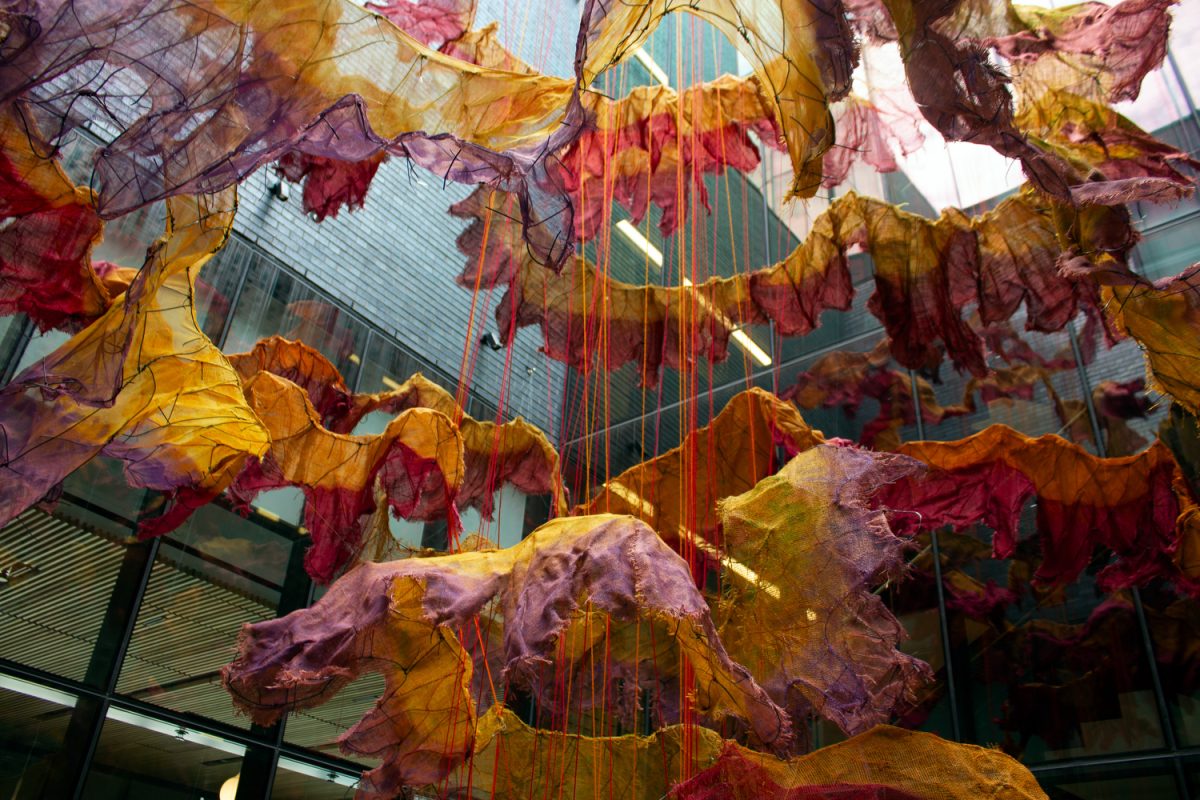In an effort to humanize inanimate objects, such as buildings, I will first identify its eyes, then its mouth and nose. As I enter the building, I will find its brain, lungs, and heart; I do this out of comfort.
At the University of Iowa’s Stanley Museum of Art, I found a beating heart in “Spirit Dance,” a 59-foot installation in the Stanley’s lightwell, yet I felt anything but comfortable; this was exactly Nigerian-American contemporary artist Nnenna Okore’s goal in creating her piece and establishing its message.
Okore received her MA and MFA from the University of Iowa in 2005 and returned this July to install her piece. The installation took four days, with Okore accompanied by the Stanley’s manager of design, preparation and installation, Steve Erickson, and UI graduate students Agnes Harry Mills, Brant Weiland and Reynold Tawiah-Quashie, alongside members of the Stanley’s collection team.
“Spirit Dance” was commissioned by Cory Gundlach, the Stanley’s curator of African art, with the goal of expanding the presence of modern and contemporary African art at the museum. This piece is the second in the Stanley’s public art installation series, “Thresholds,” which focuses on platforming Iowa-affiliated artists.
RELATED: Punk-rock goes philanthropic: Iowa City artists perform in support of local charities
“The whole point of the ‘Thresholds’ series is to draw people across our threshold, to make them curious, to bring them in, to engage them in this space,” the museum’s art director Lauren Lessing said in the July 21 press release.
“Spirit Dance” is just one in Okore’s repertoire of environmentally conscious art: she has worked with rope, slings, cloth, paper, and wire to name a few, all of which were ethically sourced, eco-based materials. The piece’s name represents the African notion that every entity, from humans and non-humans to spirits, is able to enact change.
My favorite aspect of the piece was that it won’t look the same next time I see it — Okore seeks to bring awareness to environmental issues with her work, and, in doing so, often subjects her work to outdoor elements which degrade the materials over time. Her goal in accomplishing a natural and gradual alteration of the piece is to encourage viewers to become more environmentally conscious.
While harsher elements like rain and snow may damage the material, wind, for example, can be seen inhabiting her piece, often moving the structure as if it were dancing. The sculpture is made of wire boning dressed in dyed burlap, cheesecloth and jute, presented as delicate and flouncy, yet haunting as the draped materials climb upwards four floors.
The browns, reds, and oranges of the dyed materials felt very alive while also resembling a hollow carcass. The experience itself of standing under the sculpture felt isolating, as if it were just me and the building’s main organ, together in a boundless space; Okore demonstrates a clear ability to conjure a full-body experience with her work.
Likewise, Okore insists that the installation is meant to be experienced firsthand.
“Come in, walk amongst the elements, get a real visceral sense of what is happening here. Dance with the spirits,” Okore stated in the press release.
“Spirit Dance” will be available to the public at the Stanley until 2024.



